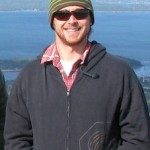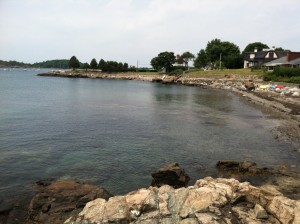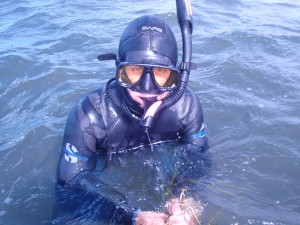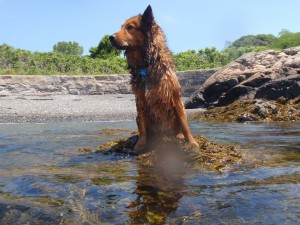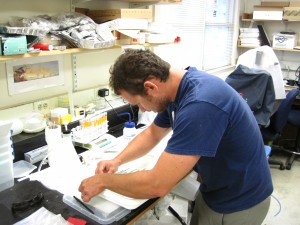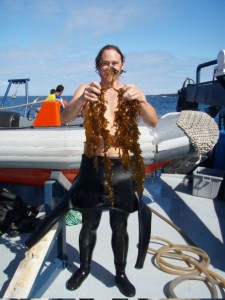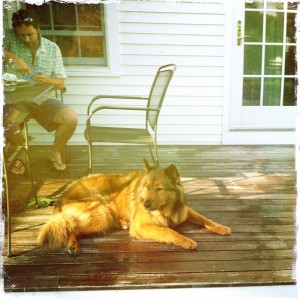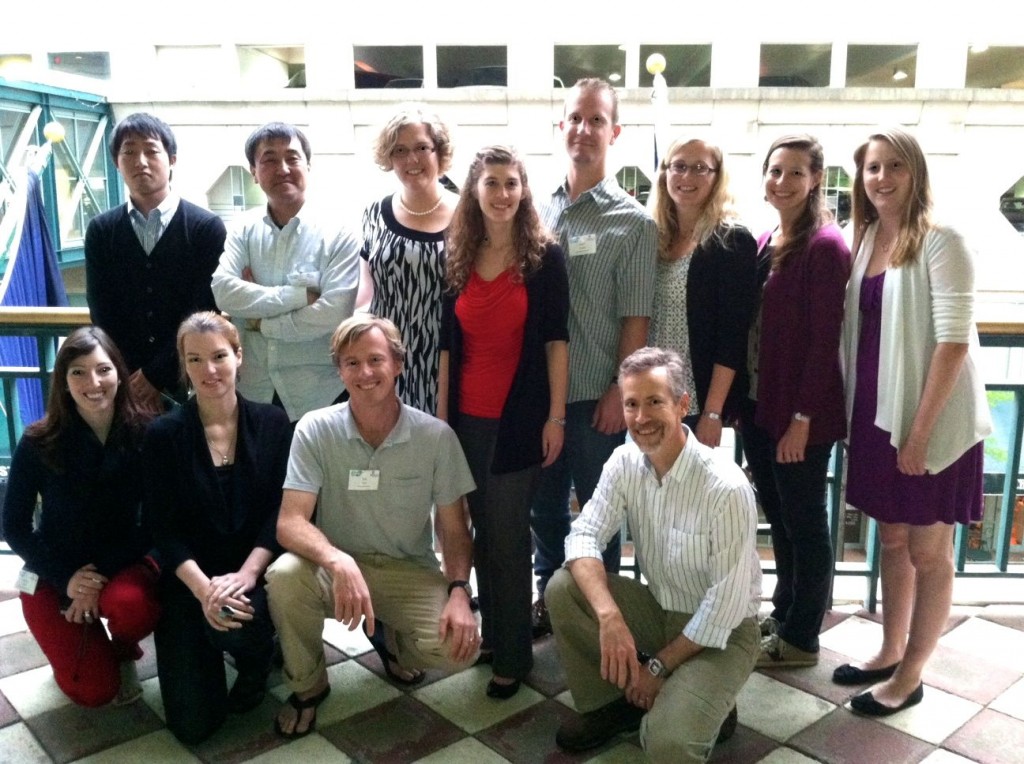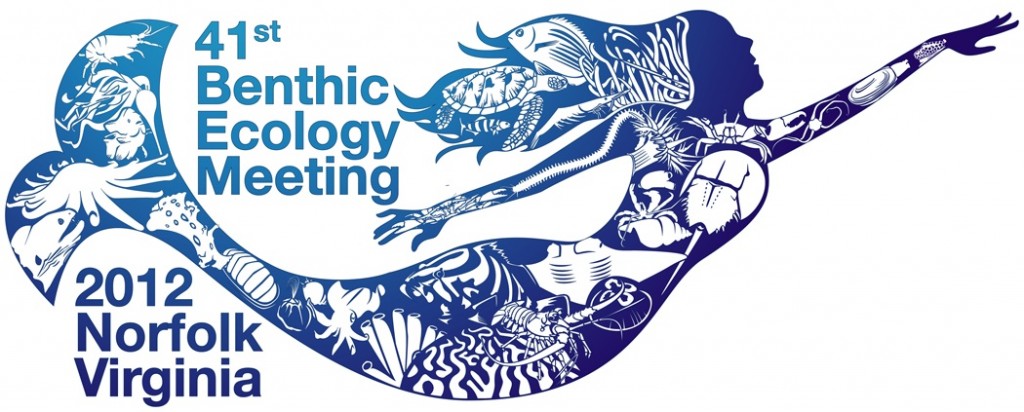An excellent day in the field
by Max Overstrom-Coleman (ZEN exchange fellow) on July 10, 2012
To be honest it is actually the 11th, but as I sit up writing this at just a shade past midnight, time seems more irrelevant than ever. I am still feeling energized from the tremendous amount of work James Douglass, my host site mentor here in Massachusetts, and I accomplished. Today we completed the sampling for the main ZEN experiment at our site. It is days like today that reinforce my love for field-work and marine science.
As I drove onto Nahant this morning the tide was halfway through its ebb and I was mentally going over the plan for what was sure to be a long day. As we envisioned it we would be in the water by about 0900 (the low was at about 1100) and our list of objectives was ambitious:
- Sample mesograzers (collect samples underwater from each experimental plot using standardized grab bags)
- Collect 10 eelgrass shoots per plot for three different analyses (1 for an analysis of epiphyte loading that would have to be done that night)
- Sample the percentage cover and canopy height of eelgrass in each plot
- Collect all of the experimental materials (bags of nutrients, plaster, and seagrass litter) to assess treatment loading and eelgrass decomposition
At this point in the season James and I are getting into a rhythm with each other. I feel like we are becoming a good team, and our ambitious plan seemed completely reasonable.
With the Northeastern Marine Lab dive truck loaded up with coolers, kayaks, dive gear and sampling equipment, we arrived at the site at a perfect tide height. The cove was empty except for a small family splashing in the shallows. It turned out that, as usual, when people show up in SCUBA gear, kids in the 8-12 age group lose their minds. I know I used to, that’s why I got certified the day I turned 13 (that was 20 years ago next week – wow I’m getting old!) and volunteered as a research diver the summer I turned 16.
It was immediately obvious that we were suddenly celebrities and it was a great opportunity to explain what we were doing and why, both to the parents and children. I think it is extremely important to communicate with the public about our research; they have to understand why it is important and see our passion. How else can we expect them to fund the science we consider so essential? In reflection, that interaction may have been one of the most important things I did today.
The sun was cooking up a hot day and it did not disappoint – I made serious strides on my raccoon tan. Before too long we were overheating and had to get in the water. I’ll spare you the nitty-gritty details, but to those of you out there who have spent that kind of time on and in the water, diving, sampling, and executing a scientific plan, I tell you honestly, it went totally smooth. By the end of it we were pretty spent and plenty hot, and it felt long but we did it without any of the usual snafus – dropped / lost / forgotten / broken gear, adverse conditions, etc… What I call an excellent day in the field.
With coolers loaded to the brim, we made it back to the lab just as we were crashing from lack of food. But after a thorough wash down to scrub off all the mud and sand that gets everywhere, and a hasty bite of food, we were back at it, preparing samples for preservation and immediately processing others. As the sunset bathed a few straggling clouds in a range of oranges and purples we were engrossed in scraping and filtering epiphytes for chlorophyll analysis, feeling pretty proud of all we accomplished. Just another day in the life of a marine ecologist.
Meet ZEN student fellow, Max
by Max Overstrom-Coleman (ZEN student exchange fellow in Massachusetts)
My name is Max. I’m a PhD student at Dartmouth College in Hanover, New Hampshire USA studying seagrass ecology. I’ve always been interested in marine biology. When I saw my first Jacques Cousteau film I knew I wanted to dedicate myself to exploring life underwater. Certified to dive when I turned 13, I took my first job as a research diver when I was 16 and never looked back. After studying coral reef cleaning symbioses in the Yucatan Peninsula for my undergraduate thesis at the College of the Atlantic, I struck out for California and the great Pacific Ocean. There, I learned of the concept of a foundation species while researching the effect that kelp, algae from the order Laminariales that can form dense forests underwater, has on both the physical and biological structure of an ecosystem. Foundation species are “a single species that defines much of the structure of a community by creating locally stable conditions for other species, and by modulating and stabilizing fundamental ecosystem processes” (Paul Dayton 1972).
Habitat forming species give life to underwater landscapes
I quickly developed a love for these habitat-forming species and I was intrigued by their influence on animal communities. That interest drove my research at Moss Landing Marine Laboratories, where I earned a master’s degree in marine science under Dr. Michael Graham. Having returned to the East Coast and the ocean I was first introduced to, the intrigue of foundational species continues to motivate my PhD research at Dartmouth College. I currently study how foundation species affect their associated communities, particularly the mechanisms influencing the role of Zostera marina (eelgrass). As with kelps, the presence of eelgrass drastically alters the physical environment and provides essential habitat for a diverse community of plants and animals. Eelgrasses influence these communities via their leaves, which provide substrate for epiphytic algae as well as offering small crustaceans, gastropods and fishes refuge from predation. These interactions are important because epiphytes are known to fuel these coastal food-webs and the refuge offered to small animals that eat epiphytes is thought to positively influence the growth of the seagrass itself.
Unfortunately, a pattern has recently emerged: seagrasses are in decline in New England and globally. The loss of seagrass populations and reductions in their density can have community-wide consequences including loss of commercially important species. My research is aimed at understanding how reduced eelgrass density affects epiphytes and the animals that depend on them. This summer I am excited to learn more about eelgrass and the role they play in structuring the communities that exist in the habitat they provide. My participation in the ZEN project will allow me to work in an eelgrass bed in Nahant, Massachusetts, help me to understand what is important for eelgrass growth and persistence and investigate what happens when it declines or is lost from a system.
Outside my life as a marine scientist
I currently live in Thetford, VT with my fantastic wife Amanda and our wonder-dog Jackson. We live on about 4 acres of land. When I am not working on the coast or studying at Dartmouth you will find me rock climbing, hiking with Jackson or working on our house/land. My recent projects include reclaiming an old apple orchard and re-siding our barn. I am especially excited about the orchard because it looks like we can expect moderate production this year (200-300 gallons) and it to increase thereafter (over 1,000 gallons next year)! Our other project for the summer are to replace our decrepit porch with a structurally sound deck on which we can enjoy BBQs and the cool night air.
ZEN at the 2012 Benthic Ecology Meeting
The Zostera Experimental Network (ZEN) team formally emerged into public view for the first time at the Benthic Ecology Meeting this past week in Norfolk, Virginia. ZEN coordinator Dr. Pamela Reynolds (top center in the photo, in red) presented a first look at the results of our 2011 experiment evaluating the relative importance of grazing, nutrient loading, and abiotic forcing on dynamics of eelgrass (Zostera marina) communities across the Northern Hemisphere.
ZEN had representation from several of our 15 global sites, and a diverse group of PIs, grad students and undergrads, at BEM this year. These included teams from northern Japan (PI Massa Nakaoka and grad student Kyosuke Momota), Quebec (graduate students Julie Lemieux and Laetitia Joseph), Massachusetts (PI James Douglass), North Carolina (PI Erik Sotka, grad students Rachel Gittman and Nicole Kollars, technicians Danielle Abbey and Alyssa Popowich), and Virginia (Emmett Duffy, Pamela Reynolds, Paul Richardson).
The abstract of Pamela’s presentation:
A comparative-experimental approach reveals complex forcing among bottom-up and top-down processes in seagrass communities across the Northern Hemisphere
Pamela L. Reynolds (1); Emmett Duffy (1); Christoffer Boström (2); James Coyer (3); Mathieu Cusson (4); James Douglass (5); Johan Eklöf (6); Aschwin Engelen (7); Klemens Eriksson (3); Stein Fredriksen (8); Lars Gamfeldt (6); Masakazu Hori (9); Kevin Hovel (10); Katrin Iken (11); Per-Olav Moksnes (6); Masahiro Nakaoka (12); Mary O’Connor (13); Jeanine Olsen (3); Paul Richardson (1); Jennifer Ruesink (14); Erik Sotka (15); Jay Stachowicz (16); Jonas Thormar (8)
(1) Virginia Institute of Marine Science, (2) Åbo Akademi University, (3) University of Gronigen, (4) Université du Québec à Chicoutimi, (5) Northeastern University, (6) University of Gothenburg, (7) Universidade do Algarve, (8) University of Oslo, (9) Fisheries Research Agency, Japan, (10) San Diego State University, (11) University of Alaska Fairbanks, (12) Hokkaido University, (13) University of British Columbia, (14) University of Washington, (15) College of Charleston, (16) University of California Davis
Two fundamental challenges to prediction in ecology are complexity and idiosyncrasy. How do we evaluate the importance and generality of multiple, interacting factors in mediating ecological structure and processes? One promising way forward is the comparative-experimental approach, integrating standardized experiments with observational data. In summer 2011 the Zostera Experimental Network (ZEN), a collaboration among ecologists across 15 Northern Hemisphere sites, initiated parallel field experiments exploring bottom-up and top-down control in eelgrass (Zostera marina) communities. Eelgrass is among the most widespread marine plants, forming ecologically and economically important but threatened coastal habitats. We factorially added nutrients and excluded small crustaceans (mesograzers) using a degradable chemical deterrent for four weeks, and measured responses of associated plant and animal communities. As expected, results varied strongly across the global range. Our cage-free deterrent strongly reduced crustacean grazers; at several sites grazer exclusion released blooms of epiphytic algae and/or sessile invertebrates. In Chesapeake Bay, these blooms reduced eelgrass biomass after eight weeks, demonstrating mutualistic dependence between eelgrass and mesograzers. Surprisingly, nutrient addition had little effect on epiphytes, except in Massachusetts and Sweden where grazers are suppressed by mesopredators. Ongoing research is analyzing the relative influence of grazer diversity and environmental forcing in mediating these processes.
Analysis of the 2011 experiments is still under way–even as we swing into high gear for planning the 2012 experiment. We will be presenting the complete results of the 2011 experiment at the Ecological Society of America meeting in Portland (August 2012) and the 47th European Marine Biology Symposium in Arendal, Norway (September 2012). We hope to see you at one or another of these events!

